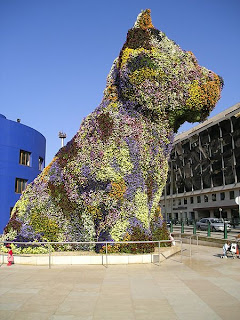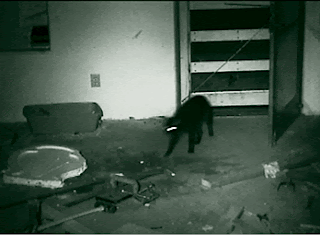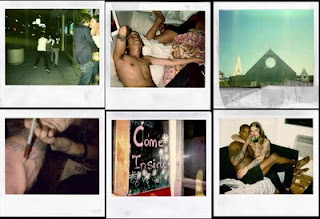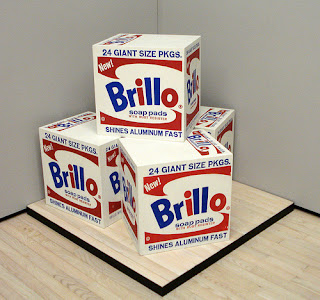In class we watched a video about the artist Vija Clemins and learned about the two Russian artists Komar and Melamid. Vija and the Russian artists use are contemporary artists that use different processes to establish their work. In the early 1990s, Komar and Melamid collaborated and worked on a project together. They surveyed people within different cultures around the world to see what artwork was preferred in different cultures. Their surveys asked various questions about what colors, scenes and type of media people would prefer in a painting. Their results expressed democratic cultural society, the difference in preferences pertaining to art and came up with statistics about the most popular and least liked paintings. Their project was called, " Most wanted Paintings On The Web." Vija Clemins art and process were very different from theirs. She was a artist who works alone and her process and are all about building a painting. She has different steps, which she takes while creating her work. She sands a canvas and paint it white and then repeat. She procreates images from magazines, photos and newspapers, as well as her own personal imagery. Her pursuit of artwork is different in that, she focuses on what the connection her paintings bring on a personal level. Vija is very exclusive while choosing her objects to paint. She is very meticulous, and will paint her works over and over again, layering one on top of the other, just to get it right. She also relies on her own expertise. I believe Vija and Komar and Melamid both have unique process, in the way they create and connect with art.
Mia Powers
Wednesday, September 29, 2010
Tuesday, September 28, 2010
Dave Hickey
Enter the Dragon: On the Vernacular of Beauty by critic Dave Hickey…Quotes from the Reading…
“… There are issues worth advancing in images that are worth admiring-that the truth is never plain nor appearances sincere. To try to make them so is to neutralize the primary, gorgeous eccentricity of imagery in the Western culture since the Reformation: the fact that it cannot be trusted, that images are always presumed to be proposing something contestable and controversial.” (Page 8)
“The task of beauty is to enfranchise the audience and acknowledge its power-to designate a territory of shared values between the image and its beholder and then, in this territory, to advance an argument by valorizing the picture’s problematic content.” (Page 9)
“… Contemporary art-no longer required to recommend images to our attention or to insinuate them into vernacular memory, no longer even to try. The route from the image to the beholder now detours through an alternative institution, ostensibly distinct from church and state.” (Page 12-13)
Here of some examples of photographs done by Robert Mapplethorpe, the artist that Dave Hickey used as an example to support his critique:
Mia Powers
Monday, September 27, 2010
Jeff Koon
Last class we were introduced to the styles and movements of art through the decades. We also looked at art by Jeff Koon, an American artist who is best known for reproducing objects such as balloon figures. Koon also worked with flowers and in 1992 he created a piece for an art exhibition Germany. This 43 foot creation was Puppy.
Wednesday, September 22, 2010
Bruce Nauman and Dash Snow: What Should Be Considered Art?
Bruce Nauman and Dash Snow were artists we looked at in order to understand and answer the questions about what art is, the creativity of art and the impressions and connections one makes with pieces of art. They both considered their everyday life to be art. Bruce Nauman is a contemporary, conceptual artist that creates videos, sculptures, paintings, neon’s and prints. He is a creative and unusual artist that looks at actions including, speech and movements and considers them art. The reactions and ideas to his pieces of artwork can be different for every viewer. Here are some of his pieces of artwork:
BRUCE NAUMAN:
Video:
"Mapping the Studio 1"
"Clown Torture"
BRUCE NAUMAN:
Video:
"Mapping the Studio 1"
"Clown Torture"
Neons:
Sculpture:

Dash Snow was another artist that used his own life to create art. His collages and Polaroid’s showed and expressed his everyday life. Although there are arguments to whether his art should have been recognized in the art world, it was recognized. Freedom to like and dislike and the process of appreciating art for whatever it might mean is extremely important in the art world. Here are a few of his pieces:

I don't find that I have a connection with Bruce Nauman's artwork. I would never be interested looking or purchasing any of his art pieces. I do not agree with him that speech and movements are art. Dash Snows artwork I believe is very interesting and expresses a world unknown to many people. I find his artwork at many times to be repulsive, but I also fine them to be intriguing, unlike Bruce Nauman's artwork.
Bruce Nauman's Videos: Documented his daily life, considered actions and movements art itself. I felt his videos weren't interesting and I don't know if I personally would consider them to be art.
Dash Snow Photo Collages: Dash Snow another artist that created his work by documenting his everyday life. Although I think his photos are incredibly a times scary, weird and extremely weird, I thought that his artwork is much more interesting then Bruce Naumans. His artwork hides nothing about his everyday life and even though sometimes its weird and hard to look at there is something intriguing about being able to see the record of his life.
Mia Powers
Friday, September 17, 2010
The Condition of Beauty
The condition of beauty and whether or not it should defined as art, is extremely controversial. A great deal of art has depicted real life horror, violence and unhappiness throughout history. We viewed many pieces of work from various artists which showed cultural horror, personal struggle and the imperfections of humanity. Artists such as Frida, Otto, Goya, Lucian Freud and Dega, set out to create real life scenarios and depictions, trying to capture the world and humanity at a specific time in history. The paintings we looked at although they were not easy to because they were so grusome, were in their own way beautiful. The colors, detail and the quality of the work is what makes it beautiful in may ways. These artists created objective art, showing the impurities of humanity through their artwork.
The question: is beauty dead, in art today?, is an important one. This question can be debated. We heard one oppinion that suggested contemporary art is the beauty of ugliness. Art makes people wake up, pay attention and then continue to think about a certain piece after seeing it. Even disturbing or horrific pieces of art grabs views attention and in many ways can be seen as being beautiful. Examples and controversies regarding this topic, are pieces of artwork such as La Pieta and Piss Christ.
John Baldessari is a conceptual artist and has his own take on what pure beauty is. He believes that art is a way of doing something that shows your understanding of the world, where things are continually changing. His technique and the way he creates conceptual art is through collage, and putting words and images together. His wok is relatable and beautiful. It shows culture and in many instances, his views and opinions of issues occuring in the world at that time. His collages are made up off things that come out of our everyday culture (magazines, photos), and are alliterated so that the images have meaning. He shows that art can be words on a colored background. His work is beautiful and brings you to attentiveness.
Mia Powers
The question: is beauty dead, in art today?, is an important one. This question can be debated. We heard one oppinion that suggested contemporary art is the beauty of ugliness. Art makes people wake up, pay attention and then continue to think about a certain piece after seeing it. Even disturbing or horrific pieces of art grabs views attention and in many ways can be seen as being beautiful. Examples and controversies regarding this topic, are pieces of artwork such as La Pieta and Piss Christ.
John Baldessari is a conceptual artist and has his own take on what pure beauty is. He believes that art is a way of doing something that shows your understanding of the world, where things are continually changing. His technique and the way he creates conceptual art is through collage, and putting words and images together. His wok is relatable and beautiful. It shows culture and in many instances, his views and opinions of issues occuring in the world at that time. His collages are made up off things that come out of our everyday culture (magazines, photos), and are alliterated so that the images have meaning. He shows that art can be words on a colored background. His work is beautiful and brings you to attentiveness.
Mia Powers
Andy Warhol
Arthur Danto is an American art critic and philosopher. We started class looking at Andy Warhol's Brillo Boxes and studying them while listening to Danto's critic. Danto's stated that art had changed drastically over history and that he always looked at art for what it was. He does not only look at the medium of a piece of art (i.e. paint, clay, charcoal), but instead looks at the artwork for a philosophical meaning. Danto once said the "the end of art" has come. He was referring to how art was changing and the way that it was becoming more conceptual, just as Andy Warhol's Boxes were. Danto was describing not the end of all art or good art , but the end of Western art. He saw that it's limitations were no longer being adhered to by artists. This made Danto begin to question what art really meant.
Damien Hirst is a conceptual artist who takes everyday objects and displays them in a way that makes people read into them. Hirst creates his artwork in a way that different viewers can see its symbolism in a variety of different ways. Hirst's artwork explores human experience in forms of death, love and hate. Conceptual art, "modern art" allows people to reflect on their impression of artwork. This is a link to a website that shows different pieces of Hirst's artwork, from painting and sculptures, to drawings. Damien Hirst
What is art?, is a question which has puzzled artists and art critics throughout history. This question is an important one when talking about conceptual art. Artists like, Marcel Duchamp began questioning art and making everyday objects into art, Andy Warhol began creating pieces which imitate other pieces, and Damien Hirst creating art from animals and everyday objects, made the question what is Art?, become even more analyzed and controversial. The definition of art changes throughout time and history.
Milton Glaser, is an artist and graphic designer. We listened to his opinion of what is art, and what art is not. He states how powerful art is for the survival of culture. In his conclusion of this question, his distinction between what is art and what is not, is based on attentiveness. Glaser believes that if something moves you to attentiveness, then its art. If it does not, then it is not art. He feels that art has changed and now has impurities, those being status and money. Status and money should not drive an artist to create artwork. Glaser ends on the issue of beauty and art. He believes that beauty is something that can bring a person to attentiveness, but that is not what makes it art. I believe art can be anything, no matter if it is beautiful or not. Milton Glaser's website: Matt Glaser's Website
For me the question, "What is art?' can not just be answered in one way. I believe that every person has their own opinion of what art is. Different views, likes and dislikes reflect ones own take on various pieces of artwork. The question is so broad and what is considered to be art in today's society is highly controversial.
Mia Powers
Damien Hirst is a conceptual artist who takes everyday objects and displays them in a way that makes people read into them. Hirst creates his artwork in a way that different viewers can see its symbolism in a variety of different ways. Hirst's artwork explores human experience in forms of death, love and hate. Conceptual art, "modern art" allows people to reflect on their impression of artwork. This is a link to a website that shows different pieces of Hirst's artwork, from painting and sculptures, to drawings. Damien Hirst
What is art?, is a question which has puzzled artists and art critics throughout history. This question is an important one when talking about conceptual art. Artists like, Marcel Duchamp began questioning art and making everyday objects into art, Andy Warhol began creating pieces which imitate other pieces, and Damien Hirst creating art from animals and everyday objects, made the question what is Art?, become even more analyzed and controversial. The definition of art changes throughout time and history.
Milton Glaser, is an artist and graphic designer. We listened to his opinion of what is art, and what art is not. He states how powerful art is for the survival of culture. In his conclusion of this question, his distinction between what is art and what is not, is based on attentiveness. Glaser believes that if something moves you to attentiveness, then its art. If it does not, then it is not art. He feels that art has changed and now has impurities, those being status and money. Status and money should not drive an artist to create artwork. Glaser ends on the issue of beauty and art. He believes that beauty is something that can bring a person to attentiveness, but that is not what makes it art. I believe art can be anything, no matter if it is beautiful or not. Milton Glaser's website: Matt Glaser's Website
For me the question, "What is art?' can not just be answered in one way. I believe that every person has their own opinion of what art is. Different views, likes and dislikes reflect ones own take on various pieces of artwork. The question is so broad and what is considered to be art in today's society is highly controversial.
Mia Powers
Marcel Duchamp
Marcel Duchamp was an artist living and creating artwork in the early 20th century. Duchamp was involved with the Surrealist and the Dadaist movements. He changed the way artwork would be created and understood. Duchamp coined the ready made concept in 1915. His artwork were existing objects that he either moved into different positions, named or slightly changed by adding another object. His first ready made object was Bicycle Wheel. He placed this object upside down on top of a stool. Duchamp then went on to create other readymades, such as the Fountain (urinal) and the Mona Lisa. Just by changing the position, adding something small to the object and giving it a title, made the objects that he was using into creative works of art. Duchamp opened doors for many artists and made it acceptable for artists to go against the norms of what actual "art" was supposed to be. Duchamp was an intellectual artist thinking about the questions of what art is, and what makes it art, even before Conceptual Art began in the 1970's. His techniques and artwork opened an entirely different world to artists, making any object, altered or not become art.
In my opinion, I don't consider readymades, like many or the pieces of artwork created by Marcel Duchamp, to be artwork. I believe artwork to me isn't just any object. Although it does show creativity in many ways, and Duchamp opened the art world to take risks outside of what was considered art, I feel that a piece of artwork has to encompass much more than what an object that is or is not altered encompasses.
Mia Powers
In my opinion, I don't consider readymades, like many or the pieces of artwork created by Marcel Duchamp, to be artwork. I believe artwork to me isn't just any object. Although it does show creativity in many ways, and Duchamp opened the art world to take risks outside of what was considered art, I feel that a piece of artwork has to encompass much more than what an object that is or is not altered encompasses.
Mia Powers
Subscribe to:
Comments (Atom)






